U.S. housing market remains surprisingly robust
 After five years of strong house price growth, the U.S. housing market remains strong. Demand is strengthening, and residential construction activity is rising.
After five years of strong house price growth, the U.S. housing market remains strong. Demand is strengthening, and residential construction activity is rising.
The was a 5.83% rise in the S&P/Case-Shillerseasonally-adjusted national home price index during 2016 (3.71% in real terms). This came after y-o-y rises of 5.27% in 2015, 4.52% in 2014, 10.74% in 2013, and 6.47% in 2012, according to Standard and Poor’s.
There was a 6.2% rise in theseasonally-adjusted purchase-only U.S. house price index from the Federal Housing Finance Agency (FHFA) (4.07% in real terms) in 2016.
All 20 major U.S. cities experienced relatively strong house price hikes, with Seattle posting the highest increase of 10.75% during 2016, according to Standard and Poor’s. It was followed by Portland (10.01%), Denver (8.89%), Tampa (8.33%), Dallas (8.06%), Miami (6.79%), Boston(6.31%), Detroit (6.27%), and Atlanta (6.21%).
The Mountain region had the highest house price increases of 8% during 2016, followed by the Pacific region (7.4%), South Atlantic (6.9%), Central region (6.2%), and the West South Central region (6.1%), according to the FHFA.
The average sales price of new homes sold in the U.S. rose by almost 12% during the year to February 2017, to US$390,400, according to the U.S. Census Bureau. In contrast, the median sales price of new homes sold dropped 4.9% to US$296,200 over the same period.
Demand has been shooting up. Sales of new single-family houses rose by 12% to 561,000 units in 2016 from the previous year, according to the U.S. Census Bureau. Likewise, existing home sales were up by 3.8% to 5.45 million units in 2016, the highest level since 2006, according to the National Association of Realtors (NAR).
“Solid job creation throughout 2016 and exceptionally low mortgage rates translated into a good year for the housing market,” said Lawrence Yun, NAR chief economist.
U.S. homebuilder sentiment surged to 71 in March 2017, up from 65 the previous month and the highest level since June 2005 according to the National Association of Home Builders (NAHB)/Wells Fargo Housing Market Index (HMI). A reading of 50 is the midpoint between positive and negative sentiment.
Construction activity continues to rise strongly. In February 2017, new housing starts rose by 6.2% y-o-y to a seasonally-adjusted annual rate of 1,288,000 units, while completions were up 8.7% to 1,114,000 units, according to the U.S. Census Bureau. Building permits (private) rose by 4.4% y-o-y to a seasonally-adjusted annual rate of 1,213,000 units in February 2017.
The U.S. housing market is expected to remain strong. NAR projects about 4% increase in the national median existing-home price this year. In addition, sales are forecast to grow by around 2% to 5.46 million this year and by another 4% to 5.68 million in 2018.
The U.S. economy grew by 1.6% in 2016, down from 2.6% growth in 2015 and the lowest level since 2011, according to the U.S. Bureau of Economic Analysis. The economic deceleration was mainly due to the slowdown in private consumption, private inventory investment, fixed investment, and government spending. The world’s largest economy is expected to grow by 2.2% this year, and by 2.1% in 2018, according to the IMF.
The story of the U.S. housing boom and bust
All 20 main U.S. cities experienced spectacular house price rises during the boom (1996-Q1 2006). Los Angeles registered the biggest house price rise of 265.5%, followed by San Diego (247.7%), San Francisco (226.6%), and Miami (213.1%).
Then in Q2 2006, house prices started to fall.
The S&P/Case-Shiller composite-20 home price index plunged 33.8% from Q2 2006 to Q4 2011. Phoenix registered the biggest drop (-55.2%) among the twenty largest metro areas, followed by Miami (-50.5%), Detroit (-42.8%), San Francisco (-41%), Los Angeles (-40.7%), and San Diego (-39.7%).
Starting the second half of 2012, the U.S. housing market started to recover, led by Phoenix. All the 20 largest cities in the U.S., except New York, saw house price rises in 2012 from a year earlier.
In 2013, Las Vegas house prices surged 25.5%, followed by San Francisco (22.6%) and Los Angeles (20.3%).
House prices continue to rise in the following years, albeit at a much slower pace. The S&P/Case-Shiller composite-20 home price index rose by 4.4% in 2014 and by 5.5% in 2015, lower than the 13.4% y-o-y growth in 2013.
HOUSE PRICE CHANGE (%) |
|||||
| US Cities | Housing boom (Jan 1996 – Mar 2006) | Housing crash, global crisis (Apr 2006 – Dec 2011) | Housing recovery (Jan 2012 – Dec 2014) | 2015 (y-o-y) | 2016 (y-o-y) |
| New York | 172.58% | -24.45% | 8.77% | 2.93% | 3.05% |
| Los Angeles | 265.49% | -40.06% | 40.94% | 6.00% | 5.38% |
| Chicago | 96.84% | -33.47% | 17.40% | 2.27% | 4.87% |
| Phoenix | 182.59% | -54.73% | 43.80% | 6.26% | 4.82% |
| San Diego | 247.66% | -39.68% | 36.74% | 7.04% | 5.39% |
| Dallas | - | -7.53% | 26.81% | 9.52% | 8.06% |
| San Francisco | 226.59% | -40.82% | 57.39% | 10.35% | 5.65% |
| Detroit | 71.99% | -43.31% | 37.86% | 6.68% | 6.27% |
| Boston | 152.49% | -16.38% | 18.32% | 4.48% | 6.31% |
| Seattle | 134.22% | -23.97% | 30.55% | 9.74% | 10.75% |
| Composite-10 | 192.25% | -33.52% | 26.75% | 4.95% | 4.88% |
| Composite-20 | - | -33.31% | 27.82% | 5.58% | 5.56% |
| Source: S&P | |||||
Housing inventory is very tight; construction far below the peak
New privately-owned housing unit starts were up by 5.6% in 2016 from a year earlier, while housing completions increased by 9.5%, according to the U.S. Census Bureau.

From 1990 to 2007, housing completions averaged 1.5 million units per year, peaking at almost 2,000 completions in 2006, but crashed to 584,900 units in 2011. Residential construction started to recover in 2012, and by 2015 was back at 968,300 units. By February 2017 new housing starts were at 1,288,000 units per year, up 6.2% y-o-y seasonally adjusted, while completions were up 8.7% to 1,114,000 units, according to the U.S. Census Bureau. However, this is still far below the peak of 2005/6.
Inventory remains tight. In February 2017, the number of new houses for sale was 266,000 units, i.e., an average supply of 5.4 months – lower than the previous year’s 5.5 months supply. Likewise, the existing homes inventory stood at 1.65 million units in December 2016, down by 6.3% from a year earlier - and the lowest level since NAR began tracking housing supply in 1999.
Foreclosures continue to fall
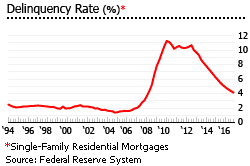
The delinquency rate on single-family residential mortgages fell to 4.15% in Q4 2016, down from 5.09% a year earlier and the lowest rate since Q1 2008, according to the U.S. Fed.
Distressed homes, i.e., foreclosures and short sales sold at discount prices, dropped to 8.9% of sales in 2016, down 2.1 percentage points from the previous year and the lowest level since 2007 when it was 6%, according to CoreLogic. Maryland had the largest share of distressed sales of any state at 17.9% in December 2016, followed by Connecticut (17.6%), Michigan (15.8%), New Jersey (15.5%) and Illinois (13.6%). In contrast, North Dakota had the smallest distressed sales share at 1.3%.
“Foreclosure and delinquency trends continue to head in the right direction powered principally by increasing employment levels, stringent underwriting standards and higher home prices over the past few years,” said AnandNallathambi, president and CEO of CoreLogic. “We expect to see further declines in delinquency and foreclosure rates in 2017,” he added.
In 2016, the cash sales share was 32.1% of total sales, down from 2.2% in 2015 and the lowest annual cash sales share since 2007, according to CoreLogic. Cash sales share peaked in January 2011 when it accounted for 46.6% of total home sales, compared to the pre-crisis level of about 25%.
Foreclosure filings, which include default notices, scheduled auctions, and bank repossessions, were reported on 933,045 properties in 2016, down by 14% a year earlier and the lowest level since 2006, according to RealtyTrac.
“The national foreclosure rate stayed within an historically normal range for the third consecutive year in 2016, even as banks continued to clear out legacy foreclosures from the last housing bubble, particularly in the final quarter of the year,” said Daren Blomquist of RealtyTrac.
There were about 379,437 repossessed properties in 2016, down 16% from a year earlier and the lowest level in a decade.
Home sales surge
Existing home sales stood at 5.45 million units in 2016, up 3.8% from a year earlier and the highest level since 2006, according to the National Association of Realtors (NAR).
- In the Northeast, existing home sales increased 2.7% y-o-y to 760,000 units in 2016.
- In the Midwest, existing home sales increased 2.4% y-o-y to 1.28 million units in 2016.
- In the South, existing home sales increased slightly by 0.4% to 2.25 million units in 2016 from a year earlier.
- In the West, existing home sales fell by 1.6% y-o-y to 1.2 million units in 2016.
Likewise, new homes sold rose by 12% to 561,000 units in 2016 from the previous year, according to the US Census Bureau - the highest number of new housing units sold since 2008. In February 2017, new homes sold increased 12.8% y-o-y to a seasonally-adjusted annual rate of 592,000 units.

The Midwest recorded the highest annual sales growth in February 2017, at more than 50%, followed by the Northeast (13.8%), the South (7.9%), and the West (6.8%).
Residential properties typically stayed on the market for 52 days in December 2016, down from 58 days in the previous year. Short sales took the longest time to sell at 97 days while foreclosures sold in 53 days. Non-distressed homes were on the market for about 50 days in December 2016.
Mortgage interest rates are rising
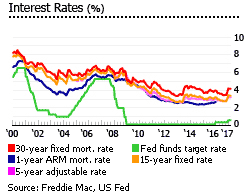
Mortgage interest rates are now rising. The Fed Funds target rate was raised in December 2015 to 0.25%-0.50% after being held at 0%-0.25% for seven years. Then in December 2016, the Fed Funds target rate was raised further to 0.50%-0.75%.
- The average interest rate for 30-year fixed rate mortgages (FRMs) rose to 4.17% in February 2017 from 3.66% a year earlier.
- The average rate for 15-year FRMs increased to 3.38% during the same period, from 2.96% in February 2016.
- The average rate for 5-year adjustable rate mortgages (ARMs) rose to 3.2% in February 2017 from 2.83% last year.
Despite the higher mortgage interest rates, the mortgage market expanded slightly to 77% of GDP in 2016, from 76.6% of GDP in 2015, but still far lower than the 100.1% of GDP in 2009, according to the U.S. Federal Reserve System.
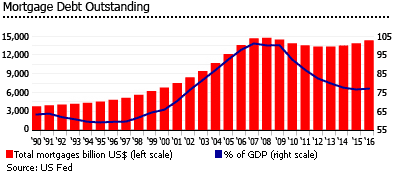
Mortgage debt outstanding rose by 3.5% y-o-y to US$14.29 trillion in 2016 from a year earlier, according to the US Fed. One- to four-family residences accounted for almost 72% of the total amount of mortgage loans outstanding in 2016.
Rents continue to rise, vacancies down

Rising rents are another sign of the increasingly healthy U.S. economy. The median asking rent in the U.S. rose by 5.3% y-o-y to US$856 per month in 2016, according to the U.S. Census Bureau.
- In the Northeast, the median asking rent rose by 3.3% during 2016, to US$995 per month.
- In the Midwest, the median asking rent rose slightly by 0.1% y-o-y to US$722 per month in 2016.
- In the South, the median asking rent rose by 6.6% y-o-y to US$835 per month in 2016.
- In the West, the median asking rent surged by 12.7% y-o-y to US$1,081 per month in 2016.
The nationwide rental vacancy rate was 6.9% in 2016, down from 7.1% in 2015, 7.6% in 2014, 8.3% in 2013, 8.7% in 2012, and 9.5% in 2011, according to the U.S. Census Bureau. In fact, it was the lowest vacancy rate recorded since 1998.
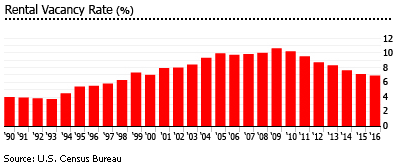
The West had the lowest rental vacancy rate of 4.7% in 2016, followed by the Northeast (5.3%), and the Midwest (7.5%). The South had the highest rental vacancy rate of 8.8% in 2016.

Median rents were more or less static from 2008 to 2014, according to the U.S. Census Bureau. However since 2015, rents have risen at least as fast as house prices.
Buyers priced out of the market
Homeownership has been falling for almost a decade in the U.S., due to rising property prices and tight credit standards. Homeownership in the U.S. was down to 63.4% of households in 2016, from 63.7% in the previous year and a peak of 69% in 2004, according to the U.S. Census Bureau.
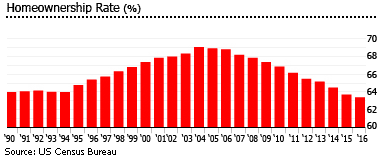
By region:
- In the Northeast, the homeownership rate dropped to 60.2% in 2016, from 60.9% a year earlier.
- In the South, the homeownership rate dropped to 65% in 2016, from 65.2% in the previous year.
- In the Midwest, the homeownership rate was 68.4% in 2016, slightly up from 68.3% in the previous year.
- In the West, homeownership rate improved to 58.5% in 2016, from 58.7% a year earlier.
Labor market is fundamentally strong

Unemployment in the U.S. was 4.7% in February 2017, down from 4.9% a year earlier, according to the Bureau of Labor Statistics (BLS). The recent peak year for unemployment was 2010, with 9.6% unemployment.
“The jobs market is strengthening and we are near full employment,” said Ryan Sweet of Moody’s Analytics.
Moreover, the total number of people seeking first-time unemployment benefits, an indicator of the pace of layoffs, reached a 44-year low in February 2017 – another indicator of strong labor market fundamentals.
In February 2017, average weekly earnings increased by 2.5% from the same period last year, to US$897.50.
Economic slowdown

The U.S. economy grew by 1.6% in 2016, down from 2.6% growth in 2015 and the lowest level since 2011, according to the U.S. Bureau of Economic Analysis. The country’s sluggish economic growth was one reason behind President Donald Trump’s election. Trump promised to doubleeconomic growth through an ambitious stimulus program featuring tax cuts, deregulation and higher infrastructure spending.
The world’s largest economy is expected to grow by 2.2% this year, and by 2.1% in 2018, according to the IMF.
The budget deficit widened to 3.2% of GDP in 2016, after reaching an eight-year low of 2.5% of GDP in 2015, according to the Congressional Budget Office (CBO). Despite this, the deficit remains far lower than the deficit of 10.1% of GDP recorded in 2009.
The deficit is expected to increase in coming years as President Trump and congressional Republicans plan to cut taxes and boost infrastructure spending.
Consumer prices continue to rise. In February 2017, the nationwide inflation rate stood at 2.7%, up from 2.5% in the previous month and the highest level in five years, according to the US Bureau of Labor Statistics. Overall inflation is expected to be 2.3% this year, from 1.2% in 2016, 0.1% in 2015, 1.6% in 2014, 1.5% in 2013, and 2.1% in 2012, according to the IMF.